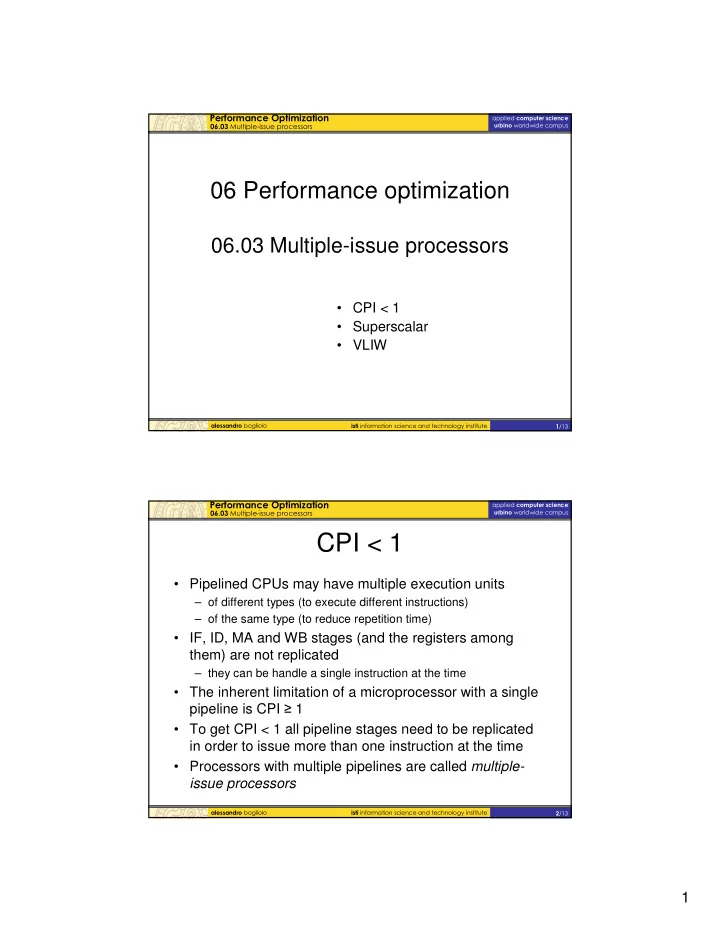

������������������������ �������� ���������������� ����� ������������������������� ������ ���������������� 06 Performance optimization 06.03 Multiple-issue processors • CPI < 1 • Superscalar • VLIW ���������� �������� ���� �������������������������������������������� � ��� ������������������������ �������� ���������������� ����� ������������������������� ������ ���������������� CPI < 1 • Pipelined CPUs may have multiple execution units – of different types (to execute different instructions) – of the same type (to reduce repetition time) • IF, ID, MA and WB stages (and the registers among them) are not replicated – they can be handle a single instruction at the time • The inherent limitation of a microprocessor with a single pipeline is CPI � 1 • To get CPI < 1 all pipeline stages need to be replicated in order to issue more than one instruction at the time • Processors with multiple pipelines are called multiple- issue processors ���������� �������� ���� �������������������������������������������� � ��� 1
������������������������ �������� ���������������� ����� ������������������������� ������ ���������������� Superscalar processors • Contain N parallel pipelines • Read sequential code and issue up to N instructions at the same time • The instructions issued at the same time must: – be independent from each other – have sufficient resources available • The ideal CPI is 1/N • If an instruction (say, instr k ) cannot be issued together with the previous ones, the previous ones are issues together and instr k is issued at the subsequent clock cycle, possibly together with some subsequent instructions ���������� �������� ���� �������������������������������������������� � ��� ������������������������ �������� ���������������� ����� ������������������������� ������ ���������������� Superscalar processors (example) • N=3 Instr6 depends instr1 IF ID EX MA WB on instr4 or instr5 instr2 IF ID EX MA WB instr3 IF ID EX MA WB instr4 IF ID EX MA WB instr5 IF ID EX MA WB instr6 IF ID EX MA WB instr7 IF ID EX MA WB instr8 IF ID EX MA WB Instr10 depends instr9 IF ID EX MA WB instr10 IF ID EX MA WB on instr9 instr11 IF ID EX MA WB instr12 IF ID EX MA WB … … … … … … • Variable issuing rate • CPI > 1/N ���������� �������� ���� �������������������������������������������� � ��� 2
������������������������ �������� ���������������� ����� ������������������������� ������ ���������������� Superscalar processors (dedicated pipelines) • In a superscalar processor, different pipelines may be devoted to different types of instructions – e.g., an integer pipeline (for integer/logic operation, memory accesses and branches), and a floating-point pipeline (for floating point operations) • All pipelines are stalled together • Different pipelines may have different latencies, but they need to have the same repetition time • To fully exploit the parallel pipelines, their instructions should appear at similar rates ���������� �������� ���� �������������������������������������������� � ��� ������������������������ �������� ���������������� ����� ������������������������� ������ ���������������� Superscalar DLX • Assumptions: – N=2 – One integer pipeline (Int) – One floating-point pipeline (FP) (ADDD has latency 3) – FP and Int do not share registers. – Decisions on parallel issuing can be taken based only on the OpCode. ���������� �������� ���� �������������������������������������������� � ��� 3
������������������������ �������� ���������������� ����� ������������������������� ������ ���������������� Superscalar DLX Int FP Loop: LD F0 , 0(R1) LD F0 , 0(R1) LD F4, -8(R1) LD F4, -8(R1) LD F6, -16(R1) ADDD F0 , F0 , F2 LD F6, -16(R1) LD F8, -24(R1) ADDD F4, F4, F2 ADDD F0 , F0 , F2 LD F10, -32(R1) ADDD F6, F6, F2 LD F8, -24(R1) SD 0(R1), F0 ADDD F8, F8, F2 ADDD F4, F4, F2 SD -8(R1), F4 ADDD F10, F10, F2 LD F10, -32(R1) SD -16(R1), F6 ADDD F6, F6, F2 SD -24(R1), F8 0(R1), F0 SD SD -32(R1), F10 ADDD F8, F8, F2 SUBI R1 , R1, #40 SD -8(R1), F4 BNEZ R1 , Loop ADDD F10, F10, F2 SD -16(R1), F6 SD -24(R1), F8 SD -32(R1), F10 SUBI R1 , R1, #40 BNEZ R1 , Loop ���������� �������� ���� �������������������������������������������� � ��� ������������������������ �������� ���������������� ����� ������������������������� ������ ���������������� Superscalar DLX Int FP Loop: LD F0 , 0(R1) LD F0 , 0(R1) LD F4, -8(R1) LD F4, -8(R1) LD F6, -16(R1) LD F6, -16(R1) ADDD F0 , F0 , F2 ADDD F0 , F0 , F2 LD F8, -24(R1) ADDD F4, F4, F2 LD F8, -24(R1) SUBI R1 , R1, #32 ADDD F6, F6, F2 ADDD F4, F4, F2 SD 32(R1), F0 ADDD F8, F8, F2 SUBI R1 , R1, #40 SD 24(R1), F4 ADDD F6, F6, F2 SD 16(R1), F6 SD 0(R1), F0 SD 8(R1), F8 ADDD F8, F8, F2 R1 , Loop BNEZ SD 32(R1), F4 SD 24(R1), F6 SD 16(R1), F8 SD 8(R1), F10 BNEZ R1 , Loop ���������� �������� ���� �������������������������������������������� � ��� 4
������������������������ �������� ���������������� ����� ������������������������� ������ ���������������� Superscalar processors performance evaluation • Assumptions: – static scheduling – sequential code available • Parse the code sequentially • Group together contiguous instructions that are not conflicting – Determine the parallel instruction count (PIC) • Insert stalls according to worst-case latency and repetition time – Determine the number of stall cycles (SC) CPUT = (PIC+SC)Tclk > IC/N * Tclk ���������� �������� ���� �������������������������������������������� � ��� ������������������������ �������� ���������������� ����� ������������������������� ������ ���������������� VLIW processors • N (from 5 to 30) parallel pipelines • Parallel code • Very long instruction words (VLIW) – Each instruction is obtained by concatenating the instructions for all the pipelines – Up 1000 bits per instruction • Static issuing, static scheduling • Instruction-level parallelism decided at compile-time • VLIW processors have simpler control units than superscalar processors ���������� �������� ���� �������������������������������������������� �� ��� 5
Recommend
More recommend